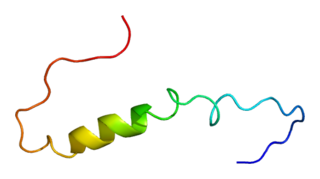The two-pore-domain or tandem pore domain potassium channels are a family of 15 members that form what is known as leak channels which possess Goldman-Hodgkin-Katz (open) rectification. These channels are regulated by several mechanisms including signaling lipids, oxygen tension, pH, mechanical stretch, and G-proteins. Their name is derived from the fact that the α subunits consist of four transmembrane segments, and each pair of transmembrane segments contains a pore loop between the two transmembrane segments. Thus, each subunit has two pore loops. As such, they structurally correspond to two inward-rectifier α subunits and thus form dimers in the membrane.

Kv7.3 (KvLQT3) is a potassium channel protein coded for by the gene KCNQ3.

Potassium voltage-gated channel subfamily D member 2 is a protein that in humans is encoded by the KCND2 gene. It contributes to the cardiac transient outward potassium current (Ito1), the main contributing current to the repolarizing phase 1 of the cardiac action potential.

Potassium intermediate/small conductance calcium-activated channel, subfamily N, member 4, also known as KCNN4, is a human gene encoding the KCa3.1 protein.

G protein-activated inward rectifier potassium channel 2 is a protein that in humans is encoded by the KCNJ6 gene. Mutation in KCNJ6 gene has been proposed to be the cause of Keppen-Lubinsky Syndrome (KPLBS).

Potassium inwardly-rectifying channel, subfamily J, member 8, also known as KCNJ8, is a human gene encoding the Kir6.1 protein. A mutation in KCNJ8 has been associated with cardiac arrest in the early repolarization syndrome.

Potassium channel subfamily K member 2 is a protein that in humans is encoded by the KCNK2 gene.

G protein-activated inward rectifier potassium channel 1(GIRK-1) is encoded in the human by the gene KCNJ3.

Potassium channel subfamily K member 3 is a protein that in humans is encoded by the KCNK3 gene.

Potassium channel subfamily K member 9 is a protein that in humans is encoded by the KCNK9 gene.

Potassium channel subfamily K member 6 is a protein that in humans is encoded by the KCNK6 gene.

Calcium-activated potassium channel subunit beta-2 is a protein that in humans is encoded by the KCNMB2 gene.

Calcium-activated potassium channel subunit beta-3 is a protein that in humans is encoded by the KCNMB3 gene.

Potassium channel subfamily K member 5 is a protein that in humans is encoded by the KCNK5 gene.

Calcium-activated potassium channel subunit beta-4 is a protein that in humans is encoded by the KCNMB4 gene.

Potassium channel, subfamily K, member 7, also known as KCNK7 or K2P7.1 is a protein which is encoded in humans by the KCNK7 gene. K2P7.1 is a potassium channel containing two pore-forming P domains. Multiple transcript variants encoding different isoforms have been found for this gene.

Potassium channel, subfamily K, member 10, also known as KCNK10 is a human gene. The protein encoded by this gene, K2P10.1, is a potassium channel containing two pore-forming P domains.

Potassium channel, subfamily K, member 12, also known as KCNK12 is a human gene. The protein encoded by this gene, K2P12.1, is a potassium channel containing two pore-forming P domains.

Potassium channel, subfamily K, member 13, also known as KCNK13 is a human gene. The protein encoded by this gene, K2P13.1 is a potassium channel containing two pore-forming P domains.
A potassium channel opener is a type of drug which facilitates ion transmission through potassium channels.
















